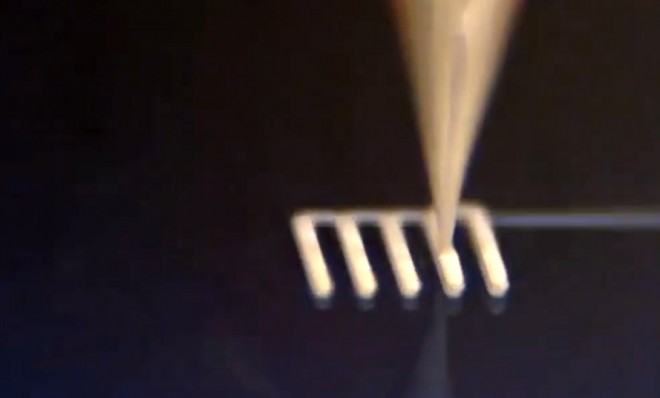3D-printed batteries the size of a grain of sand
Huge.

The dirty secret of lithium-ion batteries, which power everything from electric cars to iPhones, is that the technology hasn't had a breakthrough in years. While the rest of the technology world subscribes to Moore's law — that over time gadgets should become exponentially faster, lighter, and more compact — battery size and capacity has hit a wall. It's a problem that Apple, Samsung, Tesla, and every R&D department in the tech industry is forced to grapple with (and make concessions for) every single day.
"The problem lies in the graphite that stores lithium ions in the anode of a battery," explains TIME's Jared Newman. "Graphite has a theoretical limit to how much lithium it can hold, and today's batteries have pretty much reached it. While bigger batteries are always an option... most people don't want thicker, heavier phones."
Since portable electricity has become so critical to everything we do, and is our best hope if we're ever going to replace fossil fuels, scientists have been pouring resources into developing alternatives to lithium-ion. In the president's first term, the Obama administration invested $2.4 billion in 29 private firms to develop power cells for electric cars. And energy researchers have quietly been experimenting with all sorts of chemicals and compounds to build a better battery (with the most promising material being graphene, which has unique electrical properties that allow it to charge quickly). For the most part, however, battery tech has lagged behind other electronic advances, like flying robots the size of small insects, or tiny microphones indiscernible to the naked eye. Oftentimes the batteries that power these breakthroughs are as large as the creations themselves.
The Week
Escape your echo chamber. Get the facts behind the news, plus analysis from multiple perspectives.

Sign up for The Week's Free Newsletters
From our morning news briefing to a weekly Good News Newsletter, get the best of The Week delivered directly to your inbox.
From our morning news briefing to a weekly Good News Newsletter, get the best of The Week delivered directly to your inbox.
But perhaps we've been asking the wrong questions all along. Maybe it isn't about finding new materials with undiscovered electrochemical properties. Perhaps the key to a better battery is a matter of form.
In a new study published in the journal Advanced Materials, engineers from Harvard and the University of Illinois at Urbana-Champaign have found a way to condense the lithium-ion battery into a tightly wound shape. The microbattery they've created is incredibly tiny — about the size of a grain of sand. Its existence was made possible by the advent of 3D printing.
The team, led by senior author Jennifer Lewis, Ph.D, of the Harvard School of Engineering and Applied Sciences, realized you could pack more energy into a small shape if you could create "stacks of tightly interlaced, ultrathin electrodes that were built out of a plane." (The theory goes that if you line up electrodes on a parallel plane, the electrodes will emit more electricity.)
To accomplish this, the tiny battery's anodes and cathodes were "printed" from the ground up — like writing "Happy Birthday" on a cake with frosting. Only instead of dyed confectionery sugar, the microbattery used a "broad arrange of functional inks with useful chemical and electrical properties."
A free daily email with the biggest news stories of the day – and the best features from TheWeek.com
In this case, the inks also had to function as electrochemically active materials to create working anodes and cathodes, and they had to harden into layers that are as narrow as those produced by thin-film manufacturing methods. To accomplish these goals, the researchers created an ink for the anode with nanoparticles of one lithium metal oxide compound, and an ink for the cathode from nanoparticles of another. The printer deposited the inks onto the teeth of two gold combs, creating a tightly interlaced stack of anodes and cathodes. Then the researchers packaged the electrodes into a tiny container and filled it with an electrolyte solution to complete the battery. [Harvard]
The tiny battery's electrochemical performance is "comparable to commercial batteries in terms of charge and discharge rate, cycle life, and energy densities," says co-author Shen Dillon. "We're just able to achieve this on a much smaller scale."
From a practical standpoint, the breakthrough could have ramifications in all kinds of electronics, compact and otherwise: From the stuff we use every day (our phones) to the futuristic gadgets we've been dreaming of in science fiction (Google Glass contact lenses). Imagine a laptop crammed with thousands of microbatteries humming along in unison, or electric cars that can go months at a time in between charging stations. By finally shrinking the humble battery, we may finally be able to unlock the full potential of other stalled technologies.
That's huge.
-
 Political cartoons for January 4
Political cartoons for January 4Cartoons Sunday's political cartoons include a resolution to learn a new language, and new names in Hades and on battleships
-
 The ultimate films of 2025 by genre
The ultimate films of 2025 by genreThe Week Recommends From comedies to thrillers, documentaries to animations, 2025 featured some unforgettable film moments
-
 Political cartoons for January 3
Political cartoons for January 3Cartoons Saturday's political cartoons include citizen journalists, self-reflective AI, and Donald Trump's transparency